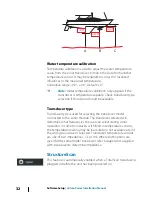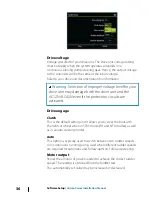
The standard value is 40 seconds which should work well on most
boats. Rule of thumb: Set to same value (seconds) as the boat’s
length in feet. On boats operating on VRF, the value should be set
to 20 seconds.
Rate limit
Sets the maximum allowed rate of turn.
The value should be kept at 6.0°/second unless there is a need for
more rapid response in turns.
Minimum rudder
This parameter filters small rudder commands to prevent high
rudder activity.
Some boats may have a tendency to not respond to small rudder
commands around the “course keeping” position because of a small
rudder, a rudder deadband, whirls/disturbance of the water-stream
passing the rudder, or it is a single nozzle water jet boat.
By increasing the Minimum rudder parameter you may improve the
course keeping performance on some boats. However, this will
increase the rudder activity.
Minimum wind angle to port and starboard
These parameters should be set identical to the minimum apparent
wind angle that will keep the sails from stalling and maintain boat
speed. The parameters vary from boat to boat.
The settings are used for the tack-prevent function. They also apply
when the autopilot is operating in WindNAV mode.
You can select different minimum wind angles for port and
starboard. The difference between port and starboard is taken into
account when calculating the Distance To Turn (DTT).
Navigation change limit
This parameter defines the maximum course change that the
autopilot is allowed to make when the Vulcan is following a route
(NAV steering).
If the required course change to the next waypoint in a route is
more than the set limit, you are prompted and must acknowledge
the course change before the autopilot will turn the vessel.
Steering response
Software Setup
| Vulcan Series Installation Manual
43
Содержание Vulcan Series
Страница 1: ...ENGLISH VulcanSeries Installation Manual bandg com...
Страница 2: ......
Страница 8: ...8 Preface Vulcan Series Installation Manual...
Страница 64: ...988 11099 001 0980...






































